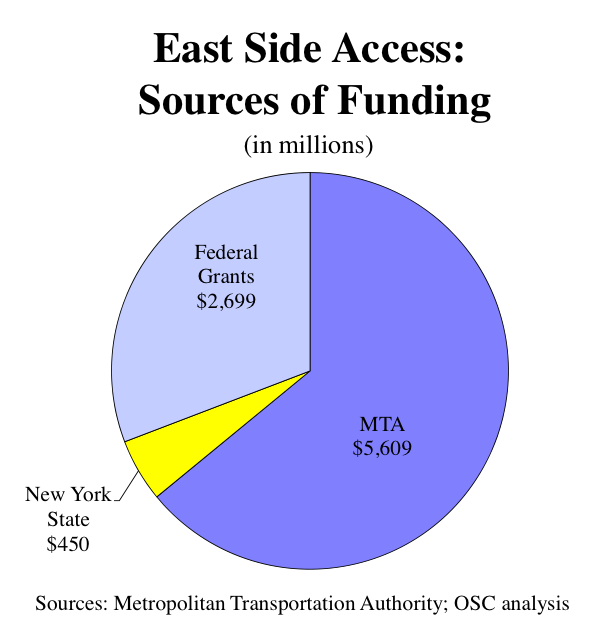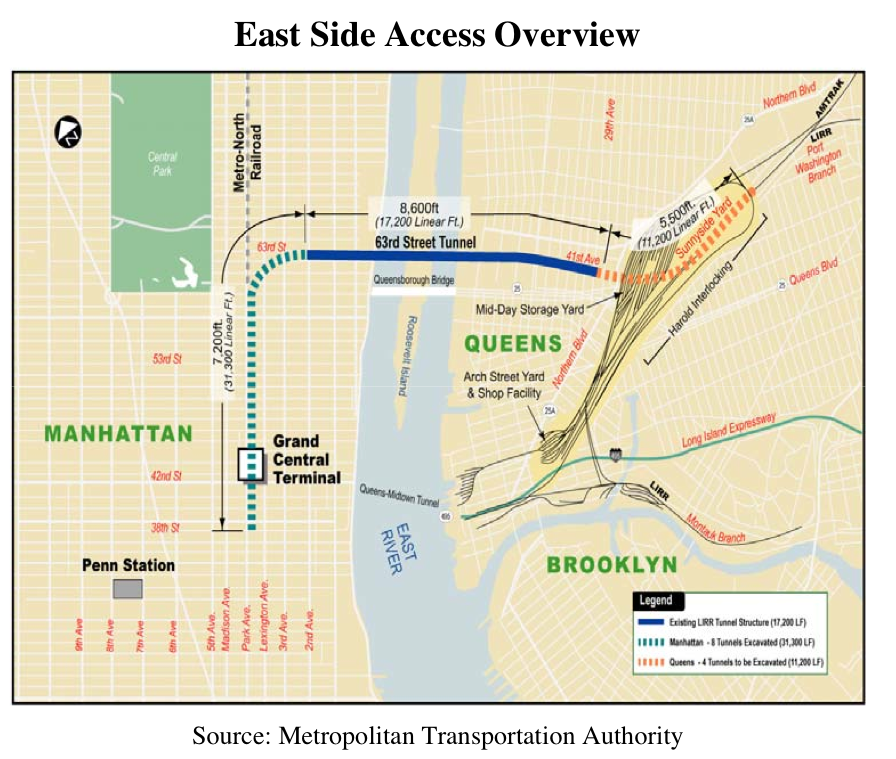NEW YORK STATE COMPTROLLER
 The Metropolitan Transportation Authority (MTA) is constructing one of the largest and most complex public works projects in the country, East Side Access (ESA). ESA will bring Long Island Rail Road (LIRR) service to the East Side of Manhattan for the first time, at Grand Central Terminal (GCT). The MTA expects ESA to spur numerous benefits for the region, including faster commutes, expanded transportation options and economic growth. Although major tunneling has been completed, ESA is less than half-finished.
The Metropolitan Transportation Authority (MTA) is constructing one of the largest and most complex public works projects in the country, East Side Access (ESA). ESA will bring Long Island Rail Road (LIRR) service to the East Side of Manhattan for the first time, at Grand Central Terminal (GCT). The MTA expects ESA to spur numerous benefits for the region, including faster commutes, expanded transportation options and economic growth. Although major tunneling has been completed, ESA is less than half-finished.
The MTA expected ESA to cost $4.3 billion in 1999 and to be completed in 2009 after eight years of construction. These estimates were based on conceptual plans made as the project was beginning its environmental review and preliminary engineering phase. The MTA claims that it was not until 2006 that the project was sufficiently designed so that reasonable budgets and schedules could be developed. By that time, the cost had grown to $6.3billion and the completion date had been pushed back to December 2013.
The MTA currently estimates that ESA will cost nearly $8.25 billion and will begin service, after 18 years of construction, by August 2019 (ten years later than originally planned). The estimated cost, however, will reach $8.76 billion (more than twice the original estimate and $2.4 billion more than the MTA’s 2006 estimate) when the MTA reflects the full cost of the passenger railcars needed to meet expected service demand.
In 1999, the merits of ESA were debated given its relatively high cost, competing capital needs and the MTA’s limited resources. Since then, the cost has more than doubled to nearly $9 billion. Although ESA is the most egregious example, the MTA has also underestimated the cost and time to complete other capital projects. The MTA must learn from this experience given its limited resources and the impact that borrowing has on the operating budget, which contributes to higher fares.
Project Overview
Plans to bring direct commuter service from Long Island and Queens to the East Side of Manhattan have been considered since at least the 1960s. In 1969, the MTA began construction of a two-level tunnel under the East River at 63rd Street, with the upper level for subway trains and the lower level reserved for future LIRR service to an eventual East Side terminal. Work on the subway component was discontinued during New York City’s fiscal crisis in the 1970s, but was finally completed in 2000.
In September 1999, the MTA estimated that ESA would cost $4.3 billion and would begin revenue service in November 2009. The MTA had originally planned to bring LIRR trains directly into the existing lower level of Grand Central Terminal (GCT), but the 2001 environmental impact statement determined that constructing a separate concourse and LIRR cavern below GCT had “substantial advantages in terms of cost, constructability, and operations, and significantly fewer . . . risks during construction.”
Preparatory construction began in late 2001, but it took another five years for the cost and design estimates to be developed sufficiently for the Federal Transit Administration (FTA) to authorize $2.7 billion toward the project under a Full Funding Grant Agreement. By that time, the cost of ESA had grown to $6.3 billion. Major tunneling contracts were awarded in 2006, 2008 and 2009.
As shown below, connecting the LIRR from its existing tracks in Queens to a new terminal below GCT entails a number of large construction tasks.
In Queens, new tunnels were bored underneath Sunnyside Yard to join the LIRR Main Line and Port Washington Branch with the lower level of the existing 63rd Street Tunnel. ESA requires extensive modifications to Harold Interlocking, a complex series of tracks and switches shared by Amtrak, the LIRR and New Jersey Transit.
At the Manhattan end of the existing 63rd Street tunnel, new tunnels were bored at depths reaching 140 feet beneath the surface, curving under Park Avenue and below the existing Metro- North Railroad tunnels to GCT.
Read full report (PDF) here: East Side Access Cost Overruns
About the Office of the State Comptroller
www.osc.state.ny.us
“The Office of the State Comptroller also establishes regulations, issues publications, conducts training and proposes legislation to improve government operations at all levels. Headquartered in Albany, OSC employs a staff of more than 2600 people and maintains offices in New York City, as well as eight regional offices which audit and provide technical assistance to local governments throughout the State. A fundamental orientation unites all the diverse activities of the Office: the State Comptroller is responsible for ensuring that the taxpayers’ money is being used effectively and efficiently to promote the common good.”
Tags: Construction, east meets west, East Side Access Cost Overruns, LIRR, MTA, New York State Comptroller







 RSS Feed
RSS Feed